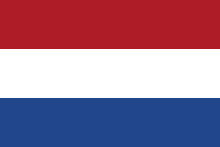Flags of white, red and blue stripes (bands) are closely associated with independence and the French Revolution. It can often signal the relationships of some nations with other nations (for instance, the flag of the Netherlands and flags of its former colonies).[1]

The Dutch tricolor, the first known example of the tricolor, stood for liberty and republicanism, and the Netherlands flag influenced the tricolour flags of France and Russia.[2]
The flag model was put forward in the French Revolution with the tricolore, a term which to this day, can refer to the flag of France directly, rather than all tricolors. The French Tricolour has become one of the most influential flags in history, with its three-colour scheme being adopted by many other nations, both in Europe and the rest of the world, and, according to the Encyclopædia Britannica has historically stood "in symbolic opposition to the autocratic and clericalist royal standards of the past".[3]
The British Union Jack was drawn up to represent the union of England and Scotland. The American flag or Stars and Stripes made a major contribution to the modern flag tradition and the idea of a flag representing both population and government, like the French flag after the Revolution.[2]
The various blue, white, and red striped banners were adopted, somewhat changing the order and position of stripes (vertical and horizontal). The Russian flag was adopted by Peter the Great on the basis of the Dutch flag, during his effort to build a Western-oriented navy.[4]
They also became the Pan-Slavic colors, particularly Austro-Slavism in countries that became independent from the Austro-Hungarian monarchy.[5]
Dual bands
editTriband
editFive bands
edit| Design | Entity, meaning | Status | Features of design |
|---|---|---|---|
| Horizontal five bands | |||
| Blue, white, red, white, blue | Cabo Verde | National | charged |
| Costa Rica | National | ||
| North Korea | National | Fimbriated, charged | |
| Allied-occupied Germany | 1946-1949 | Swallowtail | |
| Charlie | International maritime signal | ||
| Red, white, blue, white, red | Thailand | National | |
| Erie | Within USA | Fimbriated, charged | |
| Others | Bahia | State within Brazil | Cantoned |
| Richmond | Within USA | Fimbriated, charged | |
| Kirghizia | within USSR, 1952-1992 | Fimbriated, charged | |
| Puerto Rico | Within USA | ||
| Cuba | National | ||
| Vertical five bands | |||
| Blue, white, red, white, blue | Santiago del Estero | within Argentina | Charged |
More than five bands
editDifferent directions
edit- Duchy of Modena and Reggio, 1830–1859
- Netherlands Antilles, within Netherlands, cantoned, 1954-2010
- Entre Ríos, within Argentina
- Arlington, within USA, charged
- Memphis, within USA, charged
- Tuamotus, within French Polynesia, charged
- United Kingdom (Union Jack), national flag
- Norway, national, cantoned
- Iceland, national, cantoned
- Assyrian, ethnic flag
- Pará within Brazil, charged
- Amazonas within Brazil, cantoned
See also
editReferences
edit- ^ Historical Flags of Our Ancestors - South Africa Flags
- ^ a b Eriksen, Thomas Hylland; Jenkins, Richard (2007). Flag, Nation and Symbolism in Europe and America. Routledge. p. 23. ISBN 9781134066964. Retrieved 29 January 2019.
- ^ "flag of France | History & Meaning". Encyclopedia Britannica. Retrieved 2021-05-26.
- ^ "Flag of Russia". Encyclopedia Britannica. Retrieved 2021-07-22.
- ^ (Dictionary of Vexillology: P (Padded Emblem - Pantone Matching System)